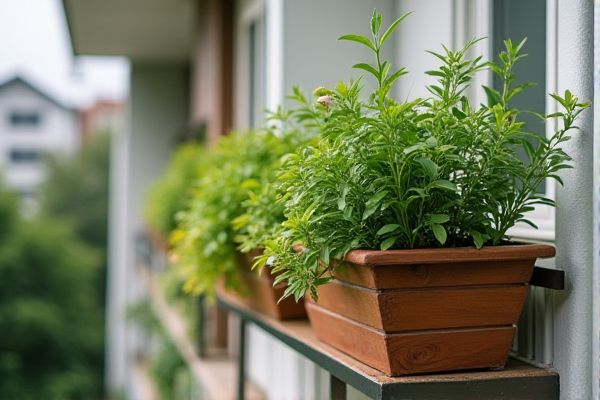
Balcony planters are designed to sit securely on the floor or ledge of your balcony, offering stability and versatility for a variety of plants, while railing planters are specifically crafted to attach directly to balcony railings, saving space and providing a decorative touch. Discover the unique advantages of each option and find the perfect solution for your outdoor gardening needs by reading the rest of this article.
Table of Comparison
| Feature | Balcony Planter | Railing Planter |
|---|---|---|
| Placement | Flat surface on balcony floor or ledge | Hangs directly on balcony railings |
| Installation | Simple setup, no attachment needed | Requires hooks or brackets to secure |
| Space Efficiency | Uses floor space, may limit walking area | Frees floor space by utilizing vertical space |
| Plant Size | Suitable for larger plants or multiple pots | Best for smaller or trailing plants |
| Stability | Generally stable on flat surfaces | Depends on railing strength and secure mounting |
| Drainage | Easy to manage with pots or built-in drainage | Must prevent water leakage onto balcony below |
| Aesthetic Appeal | Provides a grounded, substantial look | Offers a hanging, decorative effect |
| Weight Limit | Limited by floor support | Limited by railing load capacity |
Introduction: Balcony Planter vs Railing Planter
Balcony planters are designed to sit securely on the floor or edges of a balcony, providing ample space for soil and root growth, ideal for a variety of plants and flowers. Railing planters attach directly to balcony railings, maximizing vertical space and offering a stylish solution for small areas while ensuring plants receive sufficient sunlight. Choosing between a balcony planter and a railing planter depends on space availability, plant types, and sunlight exposure requirements.
Key Differences Between Balcony and Railing Planters
Balcony planters are designed to sit securely on flat surfaces, offering stability and ample soil depth for a wider range of plants, while railing planters attach directly to balcony railings using brackets or hooks, maximizing vertical space without occupying floor area. Railing planters typically have drainage systems tailored to prevent water runoff onto neighbors, whereas balcony planters may require additional drainage management. Material choices differ as well, with railing planters often being lightweight composites or metals to reduce stress on the railing, contrasting with heavier ceramic or stone balcony planters.
Space Utilization: Maximizing Small Outdoor Areas
Balcony planters maximize small outdoor areas by fitting neatly against walls or floors, allowing for versatile vertical or ground-level gardening. Railing planters optimize space by securely attaching to balcony railings, freeing up floor space and creating a tiered effect for increased planting capacity. Both options enhance urban gardening efficiency by enabling optimal use of limited square footage.
Installation Process: Ease and Requirements
Balcony planters typically offer a straightforward installation process, usually requiring just a stable surface and minimal tools, making them ideal for renters or those seeking flexible placement options. Railing planters demand secure fastening brackets or hooks designed to fit specific railing dimensions, ensuring safety and stability while often requiring more precise measurements and hardware. Your choice should consider the available support and desired mobility, as railing planters are more permanent and tailored to railing compatibility.
Design and Aesthetic Appeal
Balcony planters offer a sleek, built-in look that enhances the overall visual harmony of the outdoor space, often integrating seamlessly with the balcony structure. Railing planters provide a dynamic aesthetic by clinging to balcony edges, adding vertical greenery that maximizes space without sacrificing style. Both options support various plant types, but balcony planters typically allow for larger arrangements, creating a focal design element that transforms the ambiance.
Plant Variety and Growth Potential
Balcony planters typically offer more soil volume and depth, allowing for a wider variety of plants, including deeper-rooted vegetables and flowers, to thrive with ample growth potential. Railing planters are usually narrower and less deep, restricting plant selection to smaller herbs, trailing plants, or compact flowers that require less root space. Choosing the right planter affects your garden's diversity and overall plant health, ensuring optimal growth based on available space and plant needs.
Durability and Material Options
Balcony planters are typically made from sturdy materials like fiberglass, resin, or terracotta, offering excellent durability against weather conditions and requiring low maintenance. Railing planters often feature metal or heavy-duty plastic construction with brackets designed to securely attach to railings, ensuring stability and resistance to wind damage. Choosing the right material and design for your outdoor space significantly impacts the longevity and performance of your planter.
Safety and Stability Considerations
Balcony planters typically offer enhanced safety and stability with secure placement on flat surfaces, reducing the risk of falling compared to railing planters, which rely on clamps or brackets that may loosen over time. Railing planters, while space-efficient, require frequent checks to ensure attachments maintain a firm grip, especially during strong winds or heavy rainfall. Choosing the right option depends on your balcony's structure and how much maintenance you're willing to perform to keep your plants secure.
Maintenance and Accessibility
Balcony planters generally offer easier accessibility for watering and pruning due to their placement on flat surfaces, which reduces the risk of spills and damage. Railing planters require more careful maintenance since they are mounted on edges, making tasks like soil refilling and plant inspection slightly more challenging and demanding additional safety precautions. Choosing the right option depends on your ability to handle these maintenance factors and how accessible you need your plants to be.
Choosing the Right Planter for Your Balcony
Balcony planters provide a stable base and more soil depth, ideal for growing a variety of flowers and small vegetables directly on your balcony floor. Railing planters save space by attaching securely to balcony railings, offering excellent drainage and exposure to sunlight but with less soil volume. Your choice depends on available space, plant types, and desired maintenance, ensuring your greenery thrives in your balcony environment.
 homyna.com
homyna.com